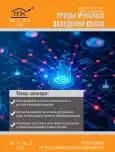Актуальность. Распределенные атаки типа «отказ в обслуживании» (DDoS) остаются значительной угрозой для доступности онлайн-сервисов. Традиционные системы обнаружения вторжений, основанные на сигнатурах или анализе аномалий, сталкиваются с ограничениями при обнаружении новых и сложных атак, в то время как подходы на основе машинного обучения, демонстрируя высокий потенциал, часто лишены интерпретируемости. Гибридные системы, такие как адаптивная нейро-нечеткая система вывода (ANFIS), объединяют преимущества нейронных сетей и нечеткой логики, предлагая как точность, так и возможность интерпретации. Однако их эффективность применительно к современным наборам данных с разнообразными векторами атак, таким как CIC-DDoS-2019, требует изучения.Цель. Исследование направлено на оценку эффективности и применимости системы ANFIS для задачи обнаружения DDoS-атак с использованием актуального и сложного набора данных CIC-DDoS-2019. В работе использовалась модель ANFIS. Исследование проводилось на репрезентативной подвыборке из набора данных CIC-DDoS-2019. Методология включала тщательную предварительную обработку данных, отбор наиболее релевантных признаков и экспертных знаний, нормализацию признаков. Модель ANFIS с гауссовыми функциями принадлежности обучалась с использованием гибридного алгоритма оптимизации (градиентный спуск и метод наименьших квадратов) на 80 % данных. Эффективность оценивалась на оставшихся 20 % тестовых данных с использованием стандартных метрик классификации: Accuracy, Precision, Recall, F1-Score, а также анализа матрицы ошибок.Результаты. Эксперименты показали высокую производительность модели ANFIS. Были достигнуты следующие показатели: доля правильно классифицированных объектов (Accuracy) – 97,82 %, точность (Precision) – 99,52 %, полнота (Recall) – 85,95 % и F1-мера – 92,24 %. Результаты указывают на очень низкий уровень ложных срабатываний, при некотором количестве пропущенных атак.Научная новизна. Работа демонстрирует применение и оценку эффективности ANFIS на современном и сложном наборе данных CIC-DDoS-2019, содержащем актуальные типы атак. Исследование подтверждает теоретическую применимость гибридных нейро-нечетких моделей для решения актуальных задач кибербезопасности. Практическая значимость состоит в демонстрации того, что ANFIS может служить основой для разработки эффективных систем обнаружения DDoS-атак, обеспечивая высокий уровень точности и приемлемую полноту обнаружения. Возможность анализа функций принадлежности и правил реализует интерпретируемость, что важно для понимания работы системы и анализа угроз. Результаты предоставляют эталонные показатели для ANFIS на данном наборе данных.
 7-24
7-24


 26‒36
26‒36


 37-46
37-46


 47-58
47-58


 59-70
59-70


 72-86
72-86


 87-96
87-96


 97-107
97-107


 108-118
108-118


 119-128
119-128







